Over the past few years, HCL’s revival of the Domino platform Domino platform has sparked renewed conversations regarding the advantages of migrating on-premise Domino systems to the cloud. Let’s talk again about why not all cloud providers are equal, especially in terms of hosting Domino, and a provider’s overall size or reputation does not guarantee the ideal balance of value and quality of service.
Not All Cloud Providers Are The Same
While we cannot vouch for other providers, we can confidently state why we are the top cloud provider for hosting the HCL Domino suite. By the end of this post, you will have a clear understanding of why.
Let’s begin with an important fact that Prominic.NET is the sole authorized HCL Cloud Hosting Partner in North America. HCL puts its cloud partners through a rigorous vetting process that involves various criteria, some of which are:
- Ability to host multi-tenant Connections, plus Sametime and Domino (for mail and apps) in a dedicated, private cloud
- Global data center ability (Prominic has its own data centers in US and partners with Equinix in Europe)
- Ability to provide L1 & L2 support
- Ability to provide 24×7 support with the exception of scheduled maintenance
- Minimum 5 years of experience hosting and operating HCL (or IBM) products (over 20 years and counting for Prominic)
- Minimum 1 HCL Ambassador
- Major data-security certifications and compliance requirement( Prominic is SSAE-18 SOC-1 and SOC-2 certified and has a full-time compliance officer on staff)
- Industry standard requirements for both physical and data security and compliance being met or exceeded (you’ll see more below)
- Disaster recovery capabilities provided to customers (also more on that below)
Prominic.NET Cloud vs On-Premise Hosting for Domino: Let’s Compare The Costs
Let’s discuss the crucial factor: cost. If the determining factor in choosing between Prominic’s cloud and on-premise is solely based on cost, how do they stack up against each other? The expenses associated with our hosting service are comparable to the tangible expenses of managing Domino in-house.
Hard Costs:

Infrastructure, support, and licensing are concrete expenses that can be easily calculated. However, there are additional costs associated with operating an on-premise data center or running Domino servers on-premises that are less apparent or difficult to quantify. Our hosting model includes these costs by default:
- Business Continuity and Disaster Recovery (BC/DR)
- Data Privacy & Compliance
- Admin & Support Expertise
Business Continuity and Disaster Recovery (BC/DR)
The top goal of business continuity efforts is to reduce disruptions to the organization’s operations due to technology failures. Every minute that a business cannot function due to data or service outages has significant financial consequences, which escalate with the size and nature of the business.
According to Gartner research, the average cost of network downtime for businesses is $5,600 per minute. Various formulas are available to determine the unique cost of network downtime, such as:

Source: https://www.gcit.net/blog/cost-of-network-downtime
Here is what each of the components of the formula are and how to calculate their costs:


Assessing the cost of network downtime is a valuable and essential exercise when deciding whether to host technology on-premises or evaluate cloud hosting providers for service reliability.
As a committed cloud hosting provider for two decades, we have made significant investments in our data centers’ infrastructure and dependability. Some elements require both financial investments and technological expertise that are inaccessible to most small to medium-sized organizations:
- backup generators for power failures
- diverse providers for Internet outages
- diverse power networks inside the data centers (A/B sides)
- private solar farm providing additional source of clean power
- redundant servers in geographically different data centers
- deep 24 x 7 monitoring with dedicated personnel and custom-built deep server monitoring software
Our hosting packages include all of these features by default, such as disaster recovery with server clustering across two entirely separate physical data centers, and autonomous data backups in each data center.
Disaster recovery costs following catastrophic events such as fires or floods are significantly higher when hosting your data on-premises.
Eliminating single points of failure and preventing data loss are crucial steps in disaster recovery planning. With on-premise data hosting, the server/s act as a single point of failure.
Even if you have an on-premises data backup system, they are often located in the same room or building as the servers, rather than being off-site. In the event of a fire, water damage, vandalism, or other unforeseen circumstances, some or all of your data, including digital and physical records, may be permanently lost. At Prominic, Domino data is replicated in real-time across two entirely separate data centers and independently backed up in each data center.
Even in a disaster at your location, as long as you can have an Internet connection, you can access your data at Prominic at all times. If you’ve done the exercise above, you can see the difference in financial impact.
After all, when it comes to either hardware failure or a major event, it’s not a question of if, but when.
Data Privacy & Compliance
A recent study from Ponemon and Globalscape reports that it is 2.71 times more costly for an organization to not comply with mandates. The average cost of compliance is $5.47 million versus an average of $14.82 million for noncompliance, which is an average difference of $9.35 million annually.
It’s not surprising that the most complicated compliance regulations are technology related and aim to safeguard data privacy.

Source: Globalscape
If you consider the man-hours necessary to dedicate to stay in compliance, it usually translates to adding a full-time compliance specialist on the payroll or dedicating a heavy portion of someone’s duties to assume the role of a compliance officer.
When you remove the physical servers from your business and all your data is located inside a compliant third-party data center like one of ours, you simplify the digital and technology portion of your compliance, as well as improve the overall physical security of your data.
The true cost of non-compliance is the reputational damage that it can cause. A study from ECGI showed that stock price reactions of negative press were 9x larger than the penalties themselves and, according to a Deloitte survey, 87 percent of executives rate reputational risk as more important than other strategic risks. These executives say that the areas of their business that were impacted the most after a negative reputational event were revenue (41 percent), loss of brand value (41 percent), and regulatory investigations (37 percent).
Here at Prominic, we believe in preserving our customers’ data privacy. Every one of our customers have separate VMs, and have full control over their virtual environment. We believe that it is our duty to protect our customers’ right to own their data, without concerns of it being mined or used for competitive advantage by their cloud provider.
Admin Expertise
When considering single points of failure for strong business continuity, don’t overlook your IT admin staff.
The difference in lost man-hours on solving problems with your Domino environment when your admin lacks the needed expertise in the Domino technology is easy enough to calculate. The lost productivity, increased stress, and decreased job satisfaction (which leads to increased turnover) are other consequences of lack of experience in administering Domino. They each have a financial impact on the organization.
With Prominic, you get 25 years and counting of some of the deepest administrative expertise with Domino in the country, with 24 x 7 accessibility to decades worth of experience managing thousands of Domino servers.
Business Outcomes
So, what does it all translate to? For most businesses, the cost-benefit analysis would weigh heavily in favor of going with Prominic’s Domino private cloud versus hosting it on-premises.
The benefits extend far beyond the simple bottom line, however. To begin with, the first outcome our customers get is a peace of mind. Our extensive BC/DR measures and staff expertise make sure your business can keep running and your data is reliably available to internal and/or external users. We really have thought of everything with regards to running their Domino applications and Notes Verse mail, so you don’t have to.
This, in turn, frees up your IT and business management to focus on other tasks and areas of the business. Reliable service and competent support improves your user experience, both internally and externally. Improved data privacy protection and improved compliance mean lessened risks of penalties and reputational damage.
Hopefully, this article gave you some clarity on the subject of costs of Domino on-premise vs our cloud. If you have some questions or comments, please feel welcome to reach out to us.
